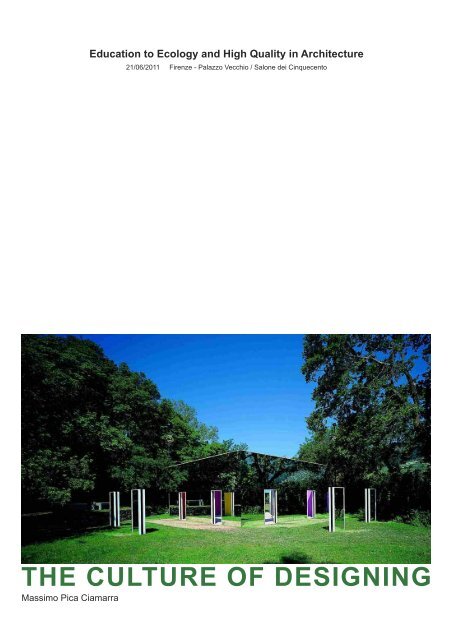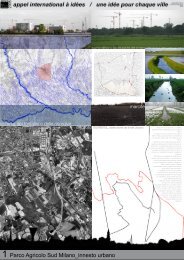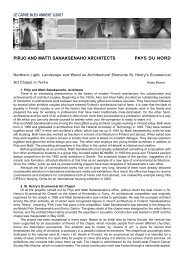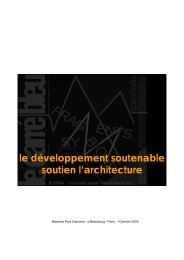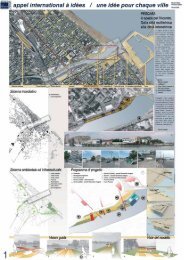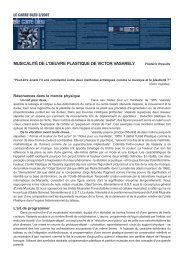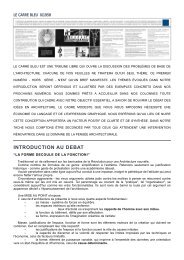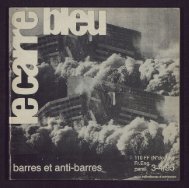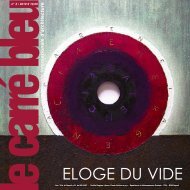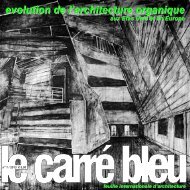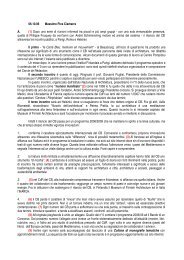THE CULTURE OF DESIGNING - Le Carré Bleu
THE CULTURE OF DESIGNING - Le Carré Bleu
THE CULTURE OF DESIGNING - Le Carré Bleu
Create successful ePaper yourself
Turn your PDF publications into a flip-book with our unique Google optimized e-Paper software.
Education to Ecology and High Quality in Architecture<br />
21/06/2011 Firenze - Palazzo Vecchio / Salone dei Cinquecento<br />
<strong>THE</strong> <strong>CULTURE</strong> <strong>OF</strong> <strong>DESIGNING</strong><br />
Massimo Pica Ciamarra
4<br />
LA FOLLIA DELLE CITTA<br />
E DEI TERRITORI<br />
la follia dell’universo<br />
dell’esistenza<br />
del diritto<br />
della politica<br />
della comunicazione<br />
della pubblicità<br />
dell’impresa<br />
dell’organizzazione<br />
+<br />
A.<br />
Almost one year ago -in another extraordinary<br />
wonderful place because of its landscape, poetry<br />
and architecture- a Seminar (2) on “madness” was held:<br />
madness of the universe, madness of life, of law, of<br />
politics, of communication, of advertising, of enterprises,<br />
madness of organization.Although it had been promoted<br />
by an INARCH past-President, in the Seminar the<br />
madness of the city and of territories was not included.<br />
There were 8 types of “madness”, like “Civilized Man's<br />
Eight Deadly Sins” among which -in the ‘70s- Konrad<br />
Lorenz had included a clear and terrifying analysis of<br />
contemporary suburbs: (3) he compared the unwinding<br />
of the built on the territory to a myriad of cells that have<br />
lost what has to keep them together, “information”,<br />
exactly as happens in neo-plastic disease. Not<br />
considering basic the relations between the individual<br />
buildings is inborn in the culture of separation, which has<br />
been working, for a long time, on classifications,<br />
distinctions, types, lots, enclosures and has focused on<br />
technologies and components of the individual buildings,<br />
identifying the quality of architecture with performances,<br />
technologies, styles and forms. In this way the cities,<br />
from wonderful expressions of human creativity, have<br />
transformed into expressions of madness.<br />
(4) In primordial beings -poor in interrelations, as<br />
transparent as jellyfish- the relations with space were<br />
caused by light and darkness, perhaps also colours,<br />
heat and chemical stimuli. In higher organisms -no<br />
longer transparent, but opaque- the skin makes relations<br />
possible, it helps setting connections and the most<br />
diverse functions of communication. In other words, in<br />
the biological world, the evolution of transparent and<br />
symmetrical structures into the opaque ones creates a<br />
new level of life: the individual is no longer alone but<br />
predisposed to super-individuality. It is easy to
paraphrase this analysis, to replace “individual” with<br />
“building”: what delimits it expresses its individuality, but<br />
above all its ability to participate in the urban scene, to<br />
relate itself to and communicate with what surrounds it.<br />
Hence the interest in the city and the relations<br />
between the individual elements composing it, as is<br />
specific in our culture. (5) We come from the tradition<br />
which recognizes that cities are born when not the<br />
5<br />
6<br />
7<br />
buildings, but the spaces between the buildings take<br />
on a meaning. Or better, when this meaning prevails<br />
on the one of individual buildings, e.i. when superindividuality<br />
becomes the precondition for building.<br />
Nowadays, domotics tends to “intelligent” buildings<br />
: restricting oneself to the private, however, is “idiotic”, in<br />
the etymological sense, from “idios” in Greek “private”,<br />
from which idiots – the private man- the one who has<br />
narrow views, unlike the public man, and who does not<br />
grasp general issues, showing disdain towards<br />
contexts. (6) The madness of cities and territories lies in<br />
the abandonment of practices founded on the relations<br />
with landscape and contexts, in the senseless<br />
accumulation of basically autonomous individualities :<br />
the urban sprawl involves now also centres and<br />
memories full of meaning. Little is opposed to this way<br />
of acting, theorized and carefully regulated, unaware of<br />
the damages -not only social- produced by the loss of<br />
aggregation factors, by low density with waste of soil<br />
and resources; by compliance with unsustainable forms<br />
of urban mobility; by the under-estimation of contexts;<br />
by the prevalence of clients’ selfishness and designers’<br />
narcissism. That’s why this country -a case in point for<br />
having produced wonderful landscapes and cities by<br />
building, over centuries, interesting and pleasant placesyields<br />
to the comparison with other realities. While (7),<br />
particularly where there is no room for ideal cities,
8<br />
each transformation is nothing but a fragment which<br />
can feed of relations and dialogues with what is preexistent<br />
and with extraordinary stratifications,<br />
preventing summations of buildings which unwind on<br />
the territory with devastating results. One cannot only<br />
meet demands for transformation, it is also<br />
necessary to contribute to direct them (8) to reverse<br />
the direction of the forces bringing about the<br />
transformations in the living environment: in the<br />
balance between the powers from which they derive,<br />
political power and economic power ought to leave<br />
more room to the power of beauty, in its broadest<br />
meaning: the economic dimension of beauty ought<br />
to surface, as well as its social and civil power, the<br />
collective usefulness in pursuing it. Beauty is not only<br />
aesthetic quality: it involves sense, meanings and<br />
memories besides crucial issues for our survival :<br />
water, energy, active citizenship, participation,<br />
culture. (9) The most well-known icon of CB is the<br />
iceberg: form, what is visible, is nothing but a hint of<br />
bigger and deeper realities.<br />
Here we do not start from scratch : but, how can we<br />
get rid of usual practices and their pathological effects?<br />
Unlike elsewhere, in our territories needs for increases<br />
do not appear, there is instead a need for<br />
infrastructures, re-organization, new qualities. What is<br />
troubling is the absence of quality deriving from<br />
separations in the study sectors, from gaps between<br />
architecture and town-planning, between infrastructures<br />
and landscape, between spatial and a-spatial aspects,<br />
between space forms and human behaviour. (10) In the<br />
world scenario our contexts are now in inevitable “degrowth”:<br />
we ought to translate it into “growing with art”,<br />
and that requires communities able to ask smart<br />
demands for the transformation of their own living
environment. (11) Hence the need for diffusing literacy<br />
already in compulsory schools, shaping the clients of<br />
tomorrow, but actually everybody, above all politicians<br />
and administrators.<br />
Education to ecology and to the quality of the<br />
transformations of the living environment is an<br />
essential step to improve the demand for projects,<br />
hence the quality of the habitat. It means supplying<br />
the basic tools to read the space, understanding its<br />
differences and alternative consequences on daily<br />
life. (12) In the same direction the project of<br />
“Declaration of Human Duties” as to the habitat and<br />
life styles was launched at the Palais de Chaillot for<br />
the 50th anniversary of CB : only by involving<br />
everybody can the utopia for a better world be<br />
sustained.<br />
(13) For design, fashion, cinema, also for food,<br />
an easy comparison has made demand careful and<br />
expert; whilst the interest for physical<br />
transformations in the living environment is poor.<br />
13<br />
Design and industrial products are supported by<br />
aware demands which are mostly absent for the<br />
built. Here -where each work is a prototype and<br />
lasting in time- quality will always be unlikely if the<br />
demand for project is not higher: more than experts<br />
able to answer wrong questions or to implement<br />
exciting monads, sensitive and demanding clients<br />
and citizens are needed.<br />
Rightly asked questions feed good projects, in<br />
the long run they also affect education processes and<br />
all the factors of the production steps. (14) Acting on<br />
demand, improving it, making it aware and<br />
demanding is the root of the whole process: the wish<br />
for change is the engine of whatever transformation<br />
and the real designer is a diffused being.
16<br />
17<br />
B.<br />
(15) (16) Diffusing literacy means supplying<br />
basic elements to understand: it is a first step<br />
towards knowledge, acutely defined “infinite<br />
resource” because unlike oil, soil and other<br />
resources, the more it is diffused, the more it grows;<br />
in giving it one is not deprived of it, it multiplies<br />
instead of being depleted. (17) “Education to<br />
Ecology and to the High Quality of Architecture”<br />
connects two themes. The former permeates by<br />
now the collective imagination: an organic set of<br />
knowledge is imbued in ecology and “education to<br />
ecology” accompanies to the principles of the<br />
science which studies the relations between man<br />
and the environment. The latter -the quality of<br />
architecture- in uncertain because the term<br />
“architecture” is blurred by formal and linguistic<br />
misunderstandings, it seems to be reduced to the<br />
form of the individual buildings and be loaded with<br />
Vitruvian recollections. Architecture is not perceived<br />
as the process of “transformations of the physical<br />
environment to contribute to improve the human<br />
condition”. Architecture is not a matter of buildings:<br />
it includes infrastructures, landscape, townplanning,<br />
the built and the un-built. On the other<br />
hand, the quality of architecture involves opinions,<br />
critical judgements, assessments: any definition is<br />
partial, questionable, contradictory, not at all<br />
objective.<br />
Together, ecology and the quality of<br />
architecture state that the quality of living<br />
environments rests first of all in the logics of<br />
relation, hence it cannot be restricted to the<br />
features of the individual parts. Both ecology and<br />
the quality of architecture outline a utopian<br />
direction, to be pursued.
Are the present living environments the same<br />
as those we wanted in the past? Are they a<br />
conscious result or an unaware product? They<br />
derive from opposing actions urging them to<br />
strengthen the research line uniting us.<br />
In some sectors choices are made, the built<br />
space, on the contrary is received. How can we<br />
reverse this trend? (18) First of all by trying to open<br />
breaches in the mystery of quality. What to we mean<br />
by quality of architecture and of the living<br />
environment? Developers, producers, architects,<br />
engineers, economists, sociologists, philosophers,<br />
historians, politicians, citizens give opposing<br />
definitions of it. It is the confusion in objectives which<br />
produces uncertainty, or even leads to mistakes. In<br />
the industrial world, quality is tantamount to pre-set<br />
performances: thanks to prototypes studied step by<br />
step, its level is measurable, known ex-ante, before<br />
an element is produced. In architecture, on the<br />
contrary, -where each project is a prototype- quality<br />
is not measured. It is assessed through comparisons<br />
and critical judgements, often ex-post instead of exante.<br />
The quality of architecture does not lie in its<br />
stylistic features or in the expressive language of a<br />
building, or in the technology adopted, or in any<br />
specific parameter. In architecture the definition of<br />
“quality” does not accept codes, but there is no<br />
community or individual escaping the conditioning<br />
which derives from the quality of the environment in<br />
which they live, or from the absence of quality. (19)<br />
Architecture affects wellbeing, safety, health,<br />
behaviour, economy, sociability, sustainability. There<br />
cannot be quality of architecture without ecology, but<br />
the ecological attention -by itself- does not guarantee<br />
the quality of architecture.
C.<br />
(20) AConference without outcomes is useless.<br />
This meeting is expected to produce results,<br />
here more than elsewhere the territory is ravaged also<br />
by enforced rules, as demonstrated by the<br />
environmental disasters in the regions where illegal<br />
building is minimum. We need new rules -a different<br />
way of thinking of the transformation processes of<br />
physical space- which discourage any self-referential<br />
character in projects and ask for dialogues in the<br />
relation systems in which they participate.<br />
(21) “Sustainability Sustains Architecture” : this<br />
motto is no longer sufficient. It actually concerned<br />
only the world of designers.<br />
“Diffused quality” requires a substantial change<br />
in the conditions in which we work. We need citizens<br />
asking for demanding politicians, who want and<br />
know how to ask. (22) What are, then, the concrete<br />
consequences of this meeting? What commitments<br />
should we honour? Education to ecology and to the<br />
quality of transformations in the living environment<br />
can cause a revolution in the way of thinking and of<br />
feeling, but it requires targeted actions.<br />
This meeting aims to set up a standing “technical<br />
group” to connect ecology and the quality of<br />
architecture. The quality of the living environment<br />
rests first of all in the logics of relations between<br />
the parts: individual buildings are nothing but<br />
fragments of a whole: they have to communicate<br />
with the environment, landscape and the<br />
“stratifications” characterizing each place. In other<br />
words -also through cooperation with agencies<br />
such as RAI Educational, Pubblicità Progresso, for<br />
example for (23) comparative advertising: “Do you<br />
want to work in this office (home, factory, school,<br />
hospital…) or in another one?”- it is possible to
create teaching modules (interactive video-lessons<br />
for the different age ranges) and Internet tools; a<br />
“reasoned participation” can be favoured;<br />
“programmers” can be trained, they are unknown<br />
in Italy, but are necessary to transform demand<br />
into “project programme”.<br />
This meeting is held under the aegis of the<br />
President of the Republic and of several Ministries,<br />
but our political class is actually indifferent to<br />
architecture, does not consider it as a resource for<br />
modernization. It was not so during the Unitary<br />
State, or in the Fascist period which -by founding<br />
new towns and through architecture- wanted to link<br />
its social programme to the administration of the<br />
territory. Republican Italy has never assigned value<br />
to architecture, it has never felt the need for<br />
representation, it limited itself to meet needs and<br />
emergencies. That’s why the processes of<br />
transformation of the physical environment are<br />
practically out of control, unless one wants to<br />
maintain that the madness of cities and territories<br />
is a deliberate choice.<br />
(24) The ecological challenge urges to act by<br />
favouring the relations between things, bringing<br />
therefore to a substantial change, because where<br />
relations prevail the individual objects loose their<br />
importance, almost effacing themselves.<br />
yes , we can<br />
Source images: 1.La Cabane éclatèe aux 4 salles (Daniel Buren), La Fattoria di Celle / Pistoia ; 2. A.Pazienza, senza tit., 1982; 3/5 GoogleEarth, litorale domizio/ Rio de<br />
Janeiro; 4. Stonehenge; 6/20 <strong>Le</strong> Carrè <strong>Bleu</strong> 0/2006; 7. Alastair Magnaldo, La dernière piéce; 9. T.Pericoli; 10/22 CB 1/2011; 11.CB 4/2008 / imm.T.Pericoli; 13.CB n°4/1977 -<br />
rielab.; 14.Good 50x70, Change global climate change, Brian Hayes -USA; 15.Good 50x70, Happen now, Atsushi Nakazawa -Japan; 16.Alastair Magnaldo, senza tit. -rielab.;<br />
17.CB 2/2011;18. Pica Ciamarra Associati, Genova Ponte Parodi / Pistoia Biblioteca Sangiorgio / Università di Salerno; 12/19/24 dal web; 23 Christian Schaller, Tianjin Zhangjiawo<br />
VR China; Carlos Ferrater, Housing in Paseo de Gracia / Barcelona


